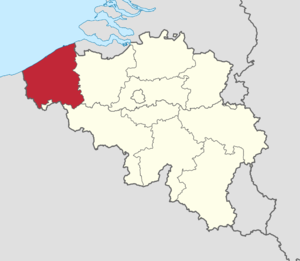West Flanders
Contents
[hide]Introduction
The region known as West Flanders (Dutch:West-Vlaanderen, French: Flandre-Occidentale) is an area in northwestern Belgium that borders France, The Netherlands, the North Sea, and the Belgian provinces of East Flanders and Hainaut. Its capital is the city of Brugge (French: Bruges), and its principal river is the Leie (French: Lys) which flows from the Pas-de-Calais region in France.
As in other areas of Belgium, there has always been a strong brewing tradition in the region which has given rise to two distinct styles: Oud Bruin and Flanders Red Ales. Though these styles are distantly related to lambic from a microbiological standpoint, these beers should not be confused with lambic from the Pajottenland / Senne Valley. That is not to say, however, that breweries in the West Flanders region have not successfully capitalized on lambic beer and culture throughout history.
Post-World War II
The immediate postwar lambic scene in and around Brussels saw both boom and bust. Large breweries like Belle Vue had remained prosperous during wartime by purchasing other smaller breweries, with other breweries struggling to remain relevant while continuing to deal with a poor economy and rationed food and supplies. The solution to some of the problems came in the form of a less harsh, commercialized sweetened lambic, whose popularity was soaring among drinkers of the time. Brewers in the Pajottenland were beginning to filter, sweeten, and pasteurize their lambic for mass consumption. Brewers outside of the Pajottenland also took notice of this trend.[1]
West Flanders thus became an area that saw an interest in producing "lambic", based on the widespread popularity of Belle Vue. Brouwerij Van Honsebrouck, whose Saint Louis line of beers are still in production today, started buying lambic wort in 1958 from Van Haelen-Coche, and Brouwerij Bockor followed suit in 1970 with their Jacobins line while purchasing wort from Brouwerij Heyvaert.[2] Additionally, Rodenbach had already been producing Saint Georges Gueuze for several decades, but ceased production in 1970 due to the popularity of their flagship beer Rodenbach, a Flanders Red Ale. These breweries were purchasing wort, transporting it to West Flanders, and aging it accordingly until their suppliers ceased production. At that time, they began producing their own version of lambic.
Brouwerij Omer Vander Ghinste (Bockor)
Main page: Brouwerij Omer Vander Ghinste (Bockor)
Brouwerij Omer Vander Ghinste was founded in 1892 and began as a family brewery. It is currently in its 4th generation of family ownership. The name Bockor was adopted for a time in 1938 but was recently changed back to Brouwerij Omer Vander Ghinste. They are known for producing Cuvée des Jacobins Rouge, a Flemish Red, and Vanderghinste, an Oud Bruin. Their flagship is Jacobins Gueuze, in addition to its spontaneously fermented beers Jacobins Kriek, Kriek Max, and Rosé Max.
Brouwerij Van Honsebrouck
Main page: Brouwerij Van Honsebrouck
Van Honsebrouck is a producer of spontaneous fermentation beers as well as ales and lagers. The brewery began producing spontaneously fermented beers based on the the success of Belle-Vue 1950s. By the early 1970's they were brewing their own lambic-style products under the name Saint Louis, using a koelschip and foeders for aging.
Rodenbach
Rodenbach produced Saint Georges Gueuze for several decades until 1970, when it ceased production due to the overwhelming popularity of their flagship beer Rodenbach, a Flemish Red Ale.
Further Research
There are records of lambic producers all across Belgium, with Brussels and the Senne Valley as it's epicenter. With limited information available, it is difficult to know definitively who was actually brewing their own lambic, who was buying lambic for blending (sometimes with their own beer), and who was buying finished lambic and relabeling it as their own. As this information becomes available, it will be documented in the Closed Lambic Producers section of the website. If you can provide any additional information, photographs, or a bottle to help further the Lambic.info initiative, please contact our primary retired brewery researcher Matt or site editors Bill or Adam.
References
- Jump up ↑ Jef Van den Steen, Geuze & Kriek: The Secret of Lambic Beer, 2012
- Jump up ↑ Raymond Buren, Gueuze, Faro, et Kriek, 1992
